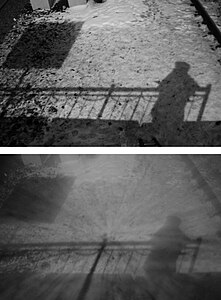Zoom burst is a photographic technique, attainable with zoom lenses with a manual zoom ring.
Using the technique involves zooming while the shutter is open with a relatively slow shutter speed, generally below 1/60 of a second. For this reason low light or small apertures are required. It is also possible to achieve a similar effect with either computer software like Adobe Photoshop (after the photo has been shot) or a photographic filter. In these cases the shutter speed can be as fast as necessary.
Photographs taken with this technique are characterized by blurred streaks emanating from the center of the photograph. The effect is nearly identical to a motion blur image in which the camera is traveling towards the subject. For this reason the zoom burst is typically used to create an impression of motion towards the subject.[1]
Examples[edit]
-
Long basement corridor, Exposure time of 1.3 sec on a 34 mm 18-55 lens
-
Costumed person during martinique carnival, Exposure time: 1/20 sec
-
Nightly skyscraper, Exposure time: 6 sec
-
The Zoom Burst effect leads to a decrease in image contrast if the exposure is not compensated. Exposure time: 3 sec
See also[edit]
References[edit]
- ^ McHugh, S.T. (2018). Understanding Photography: Master Your Digital Camera and Capture That Perfect Photo. No Starch Press, Incorporated. p. 194. ISBN 978-1-59327-894-6. Retrieved 21 September 2020.




Well, that’s interesting to know that Psilotum nudum are known as whisk ferns. Psilotum nudum is the commoner species of the two. While the P. flaccidum is a rare species and is found in the tropical islands. Both the species are usually epiphytic in habit and grow upon tree ferns. These species may also be terrestrial and grow in humus or in the crevices of the rocks.
View the detailed Guide of Psilotum nudum: Detailed Study Of Psilotum Nudum (Whisk Fern), Classification, Anatomy, Reproduction